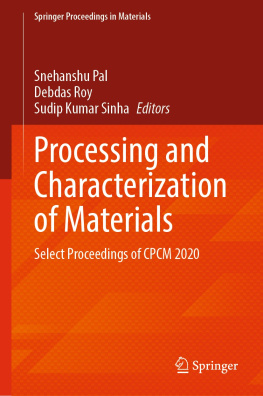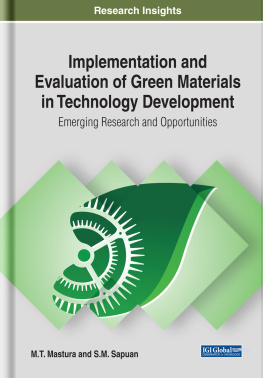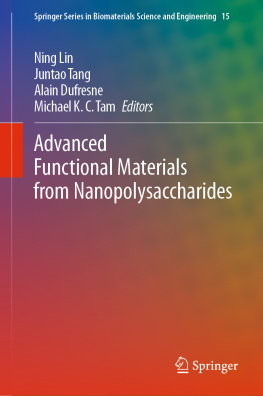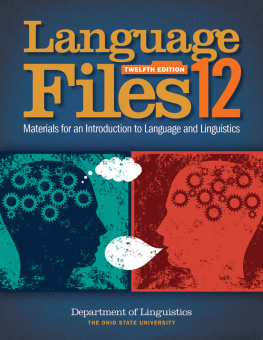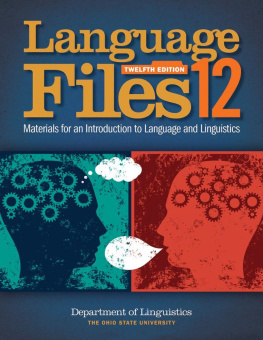Also available from Bloomsbury
Developing Materials for Language Teaching, Brian Tomlinson
Language Acquisition and Development, Brian Tomlinson
English Language Learning Materials, Brian Tomlinson
Contents
Brian Tomlinson and Hitomi Masuhara
Irma-Kaarina Ghosn
Wendy Arnold
Ben Fenton-Smith
Brian Tomlinson and Hitomi Masuhara
Jonathan Mason
Carlos Rico Troncoso
Soufiane Trabelsi
Rubena St. Louis
Saleh Al-Busaidi and Kate Tindle
Hitomi Masuhara and Brian Tomlinson
Hae-ok Park
Naeema Hann
Brian Cullen
Simon Pryor
Liliana Gottheim
Christopher Stillwell, Brian McMillan, Hamish Gillies and Tara Waller
Brian Tomlinson and Hitomi Masuhara
Christopher Stillwell, Andrew Kidd, Kamsin Alexander, Tara McIlroy, Jennie Roloff and Paul Stone
Qu Jiangqiong and Tan Bee Tin
Jayakaran Mukundan
Kwasi Opoku-Amankwa
Tim Ashwell
Jayakaran Mukundan and Touran Ahour
Freda Mishan
Peter Watkins
Marie McCullagh
Hitomi Masuhara and Brian Tomlinson
Brian Tomlinson and Hitomi Masuhara
Hitomi Masuhara and Brian Tomlinson
Figures
Tables
Touran Ahour Universiti Putra Malaysia
Saleh Al-Busaidi Sultan Qaboos University, Muscat
Wendy Arnold Coordinator of IATEFL Young Learners SIG
Tim Ashwell Komazawa University, Tokyo
Brian Cullen Nagoya Institute of Technology
Ben Fenton-Smith Griffith University, Australia
Irma-Kaarina Ghosn Lebanese American University, Byblos
Hamish Gillies Kanda University of International Studies, Japan
Liliana Gottheim Universidade Estadual de Campinas, Brazil
Naeema Hann Leeds Metropolitan University
Kamsin Alexander Kanda University of International Studies, Japan
Andrew Kidd Kanda University of International Studies, Japan
Tara McIlroy Kanda University of International Studies, Japan
Jonathan Mason University of Sousse, Tunisia
Hitomi Masuhara Leeds Metropolitan University and Azad University, Oxford
Marie McCullagh University of Portsmouth
Brian McMillan Kanda University of International Studies, Japan
Freda Mishan University of Limerick
Jayakaran Mukundan Universiti Putra Malaysia
Kwasi Opoku-Amankwa Kwame Nkrumah University of Science and Technology, Ghana
Hae-ok Park International Graduate School of English, Seoul
Simon Pryor Proto Eikaiwa, Japan
Jennie Roloff Kanda University of International Studies, Japan
Qu Jiangqiong University of Auckland
Rubena St. Louis Universidad Simn Bolvar, Venezuela
Christopher Stillwell Kanda University of International Studies, Japan
Paul Stone Kanda University of International Studies, Japan
Tan Bee Tin University of Auckland
Kate Tindle Sultan Qaboos University, Muscat
Brian Tomlinson Leeds Metropolitan University and Azad University, Oxford
Soufiane Trabelsi Leeds Metropolitan University
Carlos Rico Troncoso Leeds Metropolitan University
Tara Waller Zayed University, UEA
Peter Watkins University of Portsmouth
It has been noted by many observers (e.g. Chapelle, 2008) that there have been very few publications on research for materials development in language teaching. This has probably been because of the inevitable difficulty of isolating variables when attempting to attribute the effects of learning to the materials used and because, until recently, materials development was not considered a sufficiently academic field for research by universities and research funding councils. However now things are changing and this volume reports the results of 23 research projects conducted in 14 different countries. Most of the research projects reported are case studies of materials development in action and none of them are large, longitudinal, funded projects. This means that, while the research is systematic and rigorous, it is rarely conclusive. It is, however, indicative of a number of informative tendencies in the way that materials are developed, used and evaluated, and it provides valuable indications of the types of materials which are the most effective in facilitating language acquisition and development.
The research reports have been grouped into sections in which the chapters share objectives. At the end of each section we provide our comments on the issues which emerge from the research reported and at the end of the book we summarize what we think are the main conclusions to be drawn from the research results reported in the chapters both for second language acquisition theory and for materials development. We also discuss the applications of the findings and suggest research projects which could further increase our knowledge of the effects of different kinds of language learning materials on language acquisition and development.
Brian Tomlinson and Hitomi Masuhara
1
Published Research on Materials Development for Language Learning
Brian Tomlinson and Hitomi Masuhara
Introduction
In a plenary paper Chapelle (2008) pointed out how surprisingly little research has been published on materials evaluation. The same point could be made about the development and use of materials. If you look at the main literature on materials development in recent years (e.g. Fenner and Newby, 2000; McDonough and Shaw, 2003; McGrath, 2002; Renandya, 2003; Richards, 2001; Tomlinson, 1998a, 2003a, 2008a) you will find scholarship and theory but not very much empirical investigation. If you look at major books on language acquisition and on classroom research (e.g. Allwright and Bailey, 1991; Bailey and Nunan, 1996; Doughty and Long, 2003; Ellis, 1994, 2008; Hinkel, 2005; Lantolf, 2000; Larsen-Freeman and Long, 1991; van Lier, 1988), you will find a lot of empirical investigation of the factors which facilitate language acquisition but very little reference to the role that materials play in the process. The reasons for this seem fairly obvious. Empirical investigation of the effects of materials on language acquisition requires longitudinal research involving considerable investments of time and money. It also requires a careful control of variables which would be quite easy in controlled experiments investigating such immediate phenomenon as repair but very difficult to achieve in classroom research investigating long-term and durable effects on language acquisition and development (Tomlinson, 2007b). How, for example, can you claim that it was a particular textbook which was responsible for a measured long-term outcome and not the quality of the teaching, the rapport between teacher and class or the exposure to the target language the students gained outside the textbook? Such research is possible but very demanding and could best be achieved by long-term collaboration between publishers and universities. Publishers do, of course, conduct research into the effects of their materials on their users but, for good reasons, such research is confidential and rarely published.
Next page

